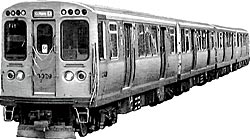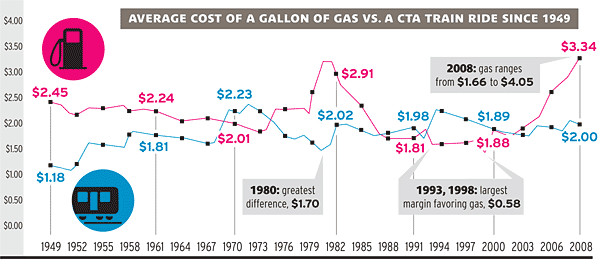
-Noelle Gaffney
With traffic getting worse and auto costs going up (did city parking-meter rates really have to jump so much?), many people are hearing the siren song of public transit—where, of course, fares have also recently increased. But because inflation has (mostly) continued its upward climb since the last fare increase, how much more is it really costing to ride the CTA?
Not much, actually, if you’re buying in bulk. In 1998, under a higher-fares strategy, the 30-day unlimited-ride pass ran $88, which is about $117 in 2008 terms, as compared with the $86 fee you may have forked over this month. That’s right—even in raw dollars, “it’s still cheaper than it was in 1997,” the Chicago Transit Authority’s spokesperson Noelle Gaffney points out.
But for individual rides, that hike from $2 to $2.25 on January 1st pushed the inflation-adjusted fare higher. In 1998, single rides cost $1.50, or about $2 in today’s dollars.
As for the costs of driving instead, what about the price of gas? In 1998 a gallon of gas was at a low of $1.41 in 2008 dollars. As of presstime, the average price of a gallon of gas was $1.66, well below the average of $3.34 for 2008. (It topped out at $4.05 in July.)
The CTA’s president, Ron Huberman, says many factors lead to raising fares: slumping tax revenue, free rides programs, and fuel costs. Also, “we’ve gone without a state capital bill for nine years,” he says, “so we’re forced to maintain older equipment longer.”
The real question is whether the increased cost will mean people stop using public transit. In 2008, ridership was up significantly at both the CTA and Metra (see sidebar), a reaction to last summer’s skyrocketing gas prices, many assume. “We [were] very packed, all year long,” says Michael Gillis, a Metra spokesman. Metra’s greatest gains came on lines that allowed riders to circumvent highway construction, but Gillis says past experience indicates that Metra won’t lose all those riders back to their cars.
More goes into transportation decisions, of course, than just the price of a ride and the price of gas. “If we talk to 20 people on the street,” says Huberman, “we’d probably get 20 reasons why transit makes sense for them.”
Photograph: Todd Urban
All Aboard
The sinking economy has led penny pinchers to public transit. Metra gained an additional 1.7 million rides between 2007 and 2008 (up to 85 million), and the CTA saw an additional 25.4 million rides systemwide, over the previous year’s 499.5 million.
| LINE | Increase (in millions of rides) | Increase (as a percentage) |
| YELLOW | 0.1 | 19.8% |
| PINK | 0.5 | 12.3% |
| PURPLE | 0.2 | 7.9% |
| BLUE | 1.9 | 6.0% |
| LOOP STATIONS | 1.1 | 5.8% |
| GREEN | 0.5 | 4.9% |
| BROWN | 0.3 | 2.8% |
| RED | 1.6 | 2.7% |
| ORANGE | 0.1 | 1.8% |
Sources: U.S. Department of Energy, CTA, U.S. Bureau of Labor Statistics
Mind the Gap
The price of a peak-period full-fare ride on a CTA train and that of a gallon of gas have been fairly close over time—with an edge to the trains—until recently. Here are the numbers, converted to 2008 dollars.

Sources: U.S. Department of Energy, CTA, U.S. Bureau of Labor Statistics


